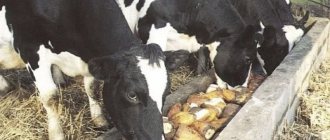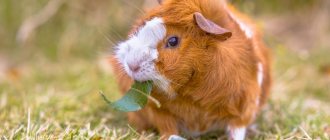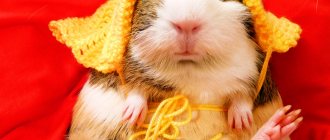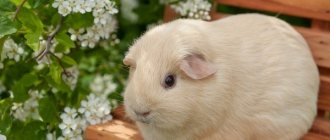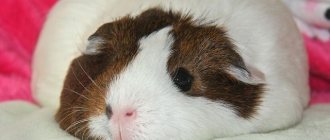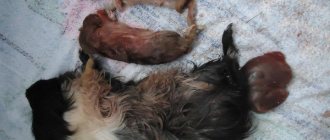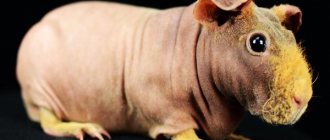How many pigs do you need to be completely happy?
Keeping a guinea pig alone should be considered animal cruelty. A lonely pig moves little, eats more and develops behavioral disorders. Such animals even live significantly less than happy relatives in the group.
If you are not ready to keep two pigs, don’t get one. A lonely animal will never be happy; guinea pigs are too determined to communicate with their own kind. After all, in nature these animals live in colonies.
Even if the pig is “friends” with the owner, with the cat, with the dog, communication with another pig will not replace it. It’s worth watching the animals that live together to understand the difference: they play, groom each other’s fur, sleep in each other’s arms, and chirp.
It’s not too late to add relatives to an adult guinea pig. Some owners don't do this to keep their pet tame and friendly. Or more correctly, painfully dependent on rare human attention. There is no need for selfishness: pigs in a group are much more interesting to watch, and they will remain tame if you devote time to them every day.
How to choose a company
You need to be guided by the fact that how rodents get along together. Don’t be nervous that the animals will start competing, because they are easy to make friends with. A large cage, toys for both and separate bowls will help avoid conflicts between rodents. It should be remembered that you cannot place a male with a female, since the inevitable mating will only interfere, especially at a young age, there is a risk of death. Even if the birth is successful, the animal will need rest for about 3-4 months, and the male will not stop, which can cause another pregnancy.
How much space does a guinea pig take up: cage arrangement
If you want to get a pig because there is not enough space in your apartment for a cat or dog, give up this idea. A guinea pig takes up more space than the largest cat and makes more noise.
You cannot keep a pig in:
- Aquarium/terrarium;
- Closed cage "dune";
- Hamster cage;
- Multi-tiered high cage for birds, chinchillas, rats.
The ideal option is an enclosure, but it is rarely built in an apartment. The cage should be one-story, 120-150 cm in length to accommodate 2-3 animals. The bigger the better, but even a spacious cage does not satisfy the need for movement, and rodents need to be allowed out of the cage for a walk (6 hours a day).
It may seem that a large cage requires a lot of filler, but in fact this is not the case: you will have to change the bedding less often than in a small cage. Bedding options:
- Paper filler;
- Wood or corn pellets combined with sawdust;
- Sawdust.
The filler should be applied in a thick layer (5 cm), changing as it gets dirty. Under it, on the bottom, you can lay an absorbent diaper. Abroad, fleece fabric is often placed on top of the filling. Fleece allows urine to flow downwards, drying instantly, and solid feces are easy to clean up. This type of bedding needs to be washed regularly.
You cannot keep your pig on a wire rack so that the excrement falls down. The grill damages the paws, causing pododermatitis.
Tunnels, houses, bridges made of ceramics or wood are placed in the cage. There are special toys for pigs - pipes made of hay, wicker balls made of straw. You can hang fabric hammocks or set up beds, but they will have to be washed often.
Prohibited:
- wheel (any size);
- walking ball;
- plastic things.
Tama the Cat: Train Station Master
This happened in the early 2000s, when the unprofitable Kishi station in the Japanese city of Kinokawa was almost closed due to unprofitability. Residents, of course, protested, but it is unlikely that their efforts would ultimately be crowned with success. The situation was saved by a local cat named Tama, who loved to bask in the sun near the train station. The station manager noticed how enthusiastically passengers reacted to this couch potato and gave him the official position of caretaker. The cat was given a uniform cap, a badge and a monthly salary in the form of free food.
The duties of the newly minted minister included advertising functions. He greeted passengers, allowed himself to be petted, and was always somewhere on the platform. It must be said that this policy very quickly led to commercial success. Tourists began to come to Kishi station just to look at the railway cat and take pictures with him. From that moment on, there was no further talk about closing the station.
But the unusual cat's career did not end there. In 2008, Tama became a supervisor and was charged with monitoring the performance of professional duties by staff. That same year, the cat was knighted. Another year later, according to the project of the famous designer Eiji Mituku, the railway included in the schedule a train dedicated to the legendary animal. The carriages were painted with views of Tama, the locomotive was decorated with his muzzle, and meowing signaled the opening (closing) of the doors. But this did not become the crown of the cat’s career.
A year later, Tamu was appointed third party of the railway company, entrusted with the post of executive director. By his old age, it was already difficult for him to work every day, and the management allowed the elderly cat to come to work 3 days a week.
Tama died at the ripe old age of 14. But even after this, the career did not end. Posthumously, the cat was elevated to the rank of Eternal Station Master, thus perpetuating his memory. After all, over the years of work, this four-legged employee has brought considerable income to his company. The tourist flow through the station increased to 300 thousand people annually, and the financial indicator amounted to more than 1.1 billion Japanese yen.
The company's management did not want to accept the loss of such a profitable and already promoted advertising brand. Tama was replaced by Nitama (the second Tama). True, later with the third cat there was an overlay. He was found at Okayama Station and offered a position in Kishi. But the owner did not agree to the move. Next came Yontama (the fourth Tama), who had already had to undergo a special training course before taking her place on the platform of the railway station.
And the flow of tourists wanting to take a photo with the legendary heirs of the first Tama still does not dry out.
I like2I don't like
What to feed your guinea pig
Basic rule: food is given without restriction. Pigs eat all the time! The basis of the diet is good quality hay, and in summer – grass. Hay is placed in the cage daily, removing yesterday's hay. Hay is needed around the clock, even if you feed green grass.
In addition to hay, an adult pig is given 150-300 g of vegetables and herbs per day, dividing the portion into several doses to avoid digestive upset. In summer they provide fresh branches with leaves.
Guinea pigs are not hamsters and do not eat grain. They do not need to be given industrial dry food at all, unless we are talking about young animals or pregnant females. When it is necessary to gain weight or increase the caloric content of the diet for another reason, food is given, but not ad libitum. The food should be for guinea pigs.
Additional treats:
- Herb seeds: fennel, dill, anise, dandelion, fescue, amaranth.
- Flaxseed or non-roasted sunflower seeds, but not all the time.
- Pet stores offer pressed hay baskets and dried plant roots (dandelion).
Fresh water is poured into a heavy ceramic bowl, and if an automatic drinking bowl is used, it is hung at muzzle level so that the pig does not have to lift its head.
Don't give pigs:
- Products of animal origin, including those containing milk.
- Sweet foods: chocolate, honey, sugar, confectionery, dried fruits, store-bought treats for rodents.
- Stone fruits (peaches, apricots, plums, cherries) and exotic (pineapple, banana, citruses).
- Plants that cause fermentation: legumes, cabbage.
- Onions, radishes, radishes, rhubarb.
- Potato.
- Cereals (rice, buckwheat and others).
- Flour (baked goods, pasta).
What to look for when purchasing
Before purchasing, you should ask the seller several important questions:
- about whether it is a female or a male;
- about age;
- availability of vaccinations;
- about health status;
- about parents;
- about food.
Girl or boy
If you plan to purchase only one animal, it does not matter whether it is a female or a male. However, remember that guinea pigs are social animals and live in groups in the wild, so it is best if you buy a pair. When planning breeding, a female or male will be required. If there is no such goal, then it is better to purchase two females - they get along well with each other.
Two males can fight for territory and inflict wounds and injuries on each other. This problem can be solved by fencing off 2 zones in the cage with bars. On the one hand, the animals will not be bored and will communicate with each other, on the other hand, clashes will be avoided.
Important! If you are purchasing a guinea pig for a child, the child must be at least 3 years old. From 3 to 6 years old, a child can play with a rodent only in your presence
A child can become a full-fledged and responsible pet owner from the age of 12.
Age
The best age to purchase a rodent is 4–5 weeks. It is not worth purchasing smaller individuals, since they still require the presence of the mother and feeding with milk. It is strictly forbidden to bring babies under 3 weeks into the house. Animals older than 5 weeks will find it more difficult to adapt to a new environment, living conditions and owner.
Behavior
When choosing an animal, preference should be given to active and inquisitive individuals who are not afraid of human approach and hands. It is better to avoid buying lethargic, passive, too timid rodents.
Important! When buying an animal, do not forget to ask the breeder what food it was fed, and take some of it from him so that the transition to a new species is comfortable for the animal.
When purchasing from a pet store or nursery, ask to sit the awake rodent on a counter or table. If at the same time he does not get scared, does not shrink into a ball, then it means he is healthy, not fearful and does not experience stress.
If you take the pig in your hands, and it does not break away, but looks at you with interest, then everything is fine with the animal, and you can safely purchase it.
Did you know? The body of guinea pigs, like humans, cannot produce vitamin C on its own. They need to replenish its reserves with food.
Health status
When you have your eye on the animal you like, you need to evaluate its behavior, and then pick it up and examine it thoroughly.
A healthy pig is characterized by:
- moderate fatness;
- shiny, clean coat, particularly around the anus;
- not liquid stool;
- activity;
- brilliant, lively eyes;
- dry paws;
- smooth, clean teeth;
- clean mucous membranes of the nose, mouth, eyes.
The presence of diseases will be indicated by:
- copious discharge from the eyes and nose;
- increased salivation;
- loose stools;
- heavy, rapid, hoarse breathing;
- bald spots on the body;
- unkempt-looking coat;
- restless or lethargic behavior;
- trembling in the body;
- excessive thirst.
Familiarize yourself with the nutrition and maintenance of guinea pigs at home.
Conditions of detention
Of course, you should not take animals if you see that they are not well-groomed and the cage in which they live is not cleaned. There is a high risk that such rodents have any diseases or are infected with parasites. A responsible breeder or seller will never allow their pets to be kept in unsanitary conditions.
Video: how to choose a guinea pig
Therefore, guinea pigs are an excellent choice for apartment living. They are flexible and friendly. They love to play, learn, and communicate with people. Can tolerate children's hugs and persistence. Guinea pigs do not require special conditions and care.
They require a spacious cage with accessories and toys, periodic cleaning of ears and teeth, trimming of claws and fur (for long-haired dogs). Only those with long hair need rare bathing.
With the right choice of a healthy individual when purchasing and proper care, a pig can live next to a person for up to 5 years. The only disadvantage of keeping a guinea pig is that this rodent is social, so to maximize its comfort you need to get it a friend.
Cons of guinea pigs: 7 fly in the ointment
There is nothing worse than disappointment from a pet. A responsible person will continue to care for the animal, but these responsibilities will not bring joy. When such an animal is gone, the owner will feel both shame and relief, but not sadness. An irresponsible person will simply get rid of an inconvenient pet, and it’s good if he finds good hands for it and does not throw it in the trash.
Before getting a guinea pig, you need to learn about the characteristics of these animals, which not everyone will like:
They make a lot of noise
Guinea pigs not only constantly chew on something, they love to dig into the litter and run around the cage. And they are capable of making a huge number of sounds. Pigs whistle shrilly, squeak, squeal, grumble, chirp, and grind their teeth.
Owners find begging to be a particularly annoying habit. As soon as you slam the refrigerator door or walk past the cage, the pig starts screaming, demanding attention or a treat.
If there are several pets, then they will talk to each other out loud, whistling about something of their own. Talkativeness is the main difference between pigs and other rodents and rabbits.
They litter and get dirty
Guinea pigs love to dig around the bedding, scattering sawdust, hay, food and their own poop around the cage. Daily housekeeping will be required to keep the room clean. In addition to cleaning around the cage, you need to regularly change the filler.
It is impossible to train a guinea pig to a litter box; it eats and poops constantly. Therefore, when you release an animal for a walk, expect to find traces of its activity everywhere.
They are afraid of people, but cannot stand loneliness
At the genetic level, the pig suspects that everyone wants to eat it. Despite the fact that these animals are not aggressive, you should not expect friendliness, trust and a desire to communicate from them either. You will have to spend time accustoming the pig to your hands. A pet can be wary of people for a long time, hiding in the house every time they try to pick it up.
However, under no circumstances should you leave the pig alone. They literally waste away and die of boredom. Ideally, you need communication with relatives. That is, in order for the pig to be happy, you must purchase two or more same-sex animals and paw them less, watching the idyll from afar.
May cause allergies
If one of your family members is allergic to cats or other animals or prone to asthma, you cannot hope that they will not be allergic to a rodent. You can check the reaction to an allergen in guinea pigs in the laboratory, or even more reliably - talk to friends or a breeder for some time with the animals.
Not only the pigs themselves can irritate the respiratory tract, but also dust from sawdust and hay, which must be present in the cage 24 hours a day.
Expensive veterinary care
These rodents have fragile health and are difficult to treat. Infectious diseases in almost 100% of cases end in death, a draft threatens pneumonia, open sunlight - heat stroke. Most often, pigs get sick from improper feeding: forbidden food causes bloating, diarrhea, and poisoning.
An ordinary veterinarian is unlikely to be able to help: the body of guinea pigs is fundamentally different from that of cats and dogs. Find out in advance whether there is a rodent specialist in your city - a rodentologist (ratologist). If not, contact experienced guinea pig breeders.
Seeing a rodentologist is an expensive pleasure. The most common reason for contacting such a specialist is the pathological growth of teeth in mumps (not only the incisors, but also the chewing teeth located deep in the mouth). If teeth are not properly ground down, they are filed under general anesthesia.
Primitive behavior
A guinea pig cannot be trained like a dog. You shouldn't expect too much from them at all. The most sociable rodents can respond to their name, but teaching them commands is a hopeless idea. They also do not take any active part in games, preferring to simply run around the room and chew everything they can get their teeth on.
Coprophagia
Like rabbits, pigs eat their own droppings. Not those solid cylinders that they leave on the litter, but the “primary” liquid, underdigested feces. The pig catches it directly from the anus, curling up into a ball.
For pigs this is absolutely normal and necessary, that’s what Mother Nature came up with. But some people find this feature off-putting.
Pair selection
Owners are concerned about the possibility of guinea pigs fighting. It is easier to prevent conflict between pets if you deliberately select suitable individuals. It is better to purchase a guinea pig from a trusted breeder. You can get information from him about the character of each animal and its position in the pack.
Important factors when choosing a pet partner:
- gender of animals;
- age;
- status in the pack;
- accommodations.
Young animals develop easier relationships with each other than adults. It is best to have two babies at once, raised together. In this case, the struggle for leadership is easier, or is not required at all. The new resident must be younger than or equal in age to the permanent resident.
The settler who dominated the previous flock will aggressively defend its position in the new place. The owner will not tolerate this and the rodents will begin to conflict. Therefore, it is better to choose a non-ambitious individual for sharing.
Patterns of groups by gender
It is not worth having a different-sex couple if breeding is not planned. Animals experience stress when living together
The female does not like the persistent attention of the male, and his constant refusals. Uncontrolled mating depletes a girl’s body
You can keep a male and female together only if the male is castrated.
Two female guinea pigs converge more easily on the same territory. Fighting for terrain between girls rarely ends in injury. This pair is optimal for a beginning livestock breeder.
Girl guinea pigs get along better than boys
Boys jealously defend their territory. Competition for the lady may break out between them. Two males don't get along well together. Vigilance is always required with them; even friendly rodents can suddenly start a fight. You can make friends between two males only if they do not smell the female.
Relationships in a pack of three or more animals develop according to the same patterns. Among the trio, an unspoken conspiracy of two pigs against the third may arise. Therefore, it is optimal to group animals into colonies of 4-5 individuals.
Summary: whether or not to get a guinea pig
Guinea pigs make wonderful pets. It's a pleasure to watch them. But you shouldn’t have them if:
- You are not ready to adopt two or more pigs at once;
- Get a guinea pig instead of a cat or dog;
- Are you going to keep the animal in a tight cage?
- Spend little time at home.
Guinea pig: keeping and caring for is a troublesome task; many people believe that caring for a cat is much easier. To prevent things from happening, as in the well-known saying “the woman had no worries, the woman bought a piglet,” assess your capabilities in advance.
If you provide a pig company with decent living conditions, the animals will delight you for many years with their cheerfulness, interesting habits and good health. Write in the comments about your pets!
If this article was helpful, please support the author HERE. You can also purchase a fictional story about the work of veterinarians “Dachshund of Fate” using the link.
Tips for choosing a leash
The anatomy of pigs is not designed for collars. One wrong move can seriously injure your pet. If you leave it free, the animal will slip out. Therefore, harnesses are the best choice for walking. They come in several types:
- In the form of a vest.
- In the form of belts.
- In the form of a figure eight.
Any of them can be purchased at a pet store or sewed yourself. The choice of harness type depends only on your pet’s preferences. The pig should be able to move comfortably and movements should be natural. There is a gap of one finger between the harness and the pet's body, which will prevent squeezing.
Anti-stress effect
In our difficult times, many people experience incredible fatigue caused by the need to deal with stress every day. And here everyone finds the necessary outlet for themselves. Some are trying to console themselves by going out with friends, others are rushing to get pets. Guinea pigs evoke many positive emotions.
These are real powerful antidepressants. If such an animal is next to you, you will not be sad
Instead of buying various sedatives, you should pay attention to the prospect of having an animal such as a hamster or guinea pig at home. Pros and cons will help you make your choice
Most often, as a result of this action, a person begins to feel additional meaning in all his daily activities. Having a little furry friend at home greatly helps fight bad moods and various fears.
Peppermint treat
Ingredients:
- 1 medium overripe banana.
- 2 chicken eggs.
- 3 tbsp. spoons of honey.
- 3 tbsp. tablespoons of liquid coconut oil (can be replaced with sunflower oil in the same amount).
- 1/2 teaspoon mint flavoring.
- 1/2 teaspoon baking powder.
- A quarter cup of carob (roasted carob powder). A small amount of cocoa can be substituted, but this is not recommended for animals. Therefore, try to find an original product.
- Oat flour.
Cooking procedure.
1. Mash the banana in a bowl.
2. Beat eggs into the resulting mass, add honey, baking powder, cinnamon and coconut (sunflower) oil.
3. Add oatmeal to the mixture to form a firm but slightly moist dough.
4. Divide the resulting volume into 2 equal parts.
5. Pour 1/4 cup of carob powder into one half, and add the same amount of flour to the second half. A hard lump should form that does not stick to your hands.
6. Roll out 2 rectangles, 9-10 mm thick.
7. Place the layers of dough on top of each other and roll along the long side. Wrap the resulting sausage in plastic wrap and put it in the refrigerator overnight.
8. Preheat the oven to 180 degrees.
9. Cover a baking sheet with parchment paper.
10. Remove the film and cut into 3-3.5 cm rounds.
11. Place on a baking sheet. During cooking, portions of dough will not increase in volume, so you can place them close to each other.
12. Bake for 10-15 minutes.
If you want to please your pet with a crunchier treat, cut the rolls into thin slices (about 1 cm), and after cooking, additionally dry them in a warm oven or even in a non-stick frying pan.
The finished product is stored for a long time in a dry place. So, by baking peppermint rolls once, you can treat your four-legged pupil with them for a long time.
Bon appetit to your dog!
I like it I don't like it
Brief information and history
Its attractive face, calm nature, affectionate disposition and quirky clumsiness make the guinea pig a desirable pet for many children. The small size of the animal allows it to be kept even in a small apartment. Financially, a pig is also more profitable than many other pets, since it eats little, accessories and a house for a rodent are inexpensive. But not everyone decides to purchase a guinea pig, fearing difficulties in caring for it.
The guinea pig is a miniature domesticated member of the pig family. The guinea pig can also be found under another name - “Guinea pig” or “Kevi”. Interestingly, the animal has nothing to do with pigs, wild boars and other representatives of the pig family, as well as with representatives of marine life. It is unlikely that they ever lived in Guinea; it is believed that the birthplace of modern guinea pigs is Peru.
The animal got a funny name in Russia, where it was delivered by sea. And the funny, elongated face resembled newborn piglets. This is where the name “Overseas Pig” came from, which over time transformed into Guinea Pig.
Kevi
Pigs began interacting with people around the 5th century BC. Aboriginal tribes domesticated small, fleshy animals for the purpose of breeding and eating them. Particularly touching individuals were kept as pets. Today, no one eats guinea pigs anymore, and their main purpose is to please their owners.
The lifespan of these small rodents largely depends on the conditions of their detention. On average, they can live from five to eight years. Among guinea pigs you can also find centenarians who lived a long life, fifteen years long. It is extremely difficult to achieve such a result; this is the exception rather than the rule, due to the genetic characteristics of the animal.
Paired content
This is also a difficult point that needs to be taken into account in a timely manner.
Guinea pigs should only be kept in same-sex pairs. If an animal is kept alone, rest assured that it will soon become ill and die. Guinea pigs are incredibly social rodents. They need communication just like air. Breeding them is quite difficult; the offspring are often born unhealthy. For this reason, you need to put a relative of the same sex in the same pig's cage. It is better to do this soon, as soon as you have a pig, or buy two pets at once.
Accordingly, all expenses double. If a person is already not rich, then it will be difficult for him to allocate funds for the maintenance of his pets.
In favor of the chinchilla
Chinchillas live on average from six to ten years. Very active and friendly, they love a lot of space. They are often allowed to walk around the house. They are housed in large metal cages with a plastic tray, often homemade. The disadvantages include a nocturnal lifestyle, it is at this time that they are most active. They sleep during the day or have lethargic behavior. For this reason, the chinchilla is not suitable for everyone, since at night it is quite noisy and interferes with sleep.
Many animals do not like being alone and need a partner. Chinchillas are not like that; they can be kept alone. Although she will not refuse a partner, since she is very sociable. It will quickly become a good companion and friend for children. In general, there are advantages to supporting one person and an entire family. The behavior is very interesting to observe from the outside, especially when they play together. The male and female during the mating season is a separate issue; they constantly chase each other around the cage or sit next to each other and watch each other.
Chinchillas are distinguished by their intelligence and ingenuity; they quickly understand what’s what and how to behave. Easy to toilet train. Some individuals are very cunning; when they need something from a person, they sit in the corner and look at him. This behavior quickly bears fruit.
You need to feed your chinchilla a variety of foods: nuts, vegetables and fruits, special food, hay, and even food from our table. The animal must have access to fresh water. Since they love to swim, a special bathing suit is left in the cage once a day for an hour.
There are several main advantages of keeping a chinchilla at home:
- Easy care;
- Rare diseases;
- No unpleasant odor;
- They make contact easily with people and animals;
- Easily tamed;
- Are subject to training;
- They never bite;
- Beautiful appearance;
- They have an interesting character and are able to quickly cheer up;
- They live 6–10 years, some individuals live up to 20.
The last fact can be attributed to pros and cons at the same time. Not everyone wants to take responsibility for an animal for a third of its life.
There is one interesting character trait: they are able to be offended and show it. If you don’t take him for a usual walk or entrust the care to other people, you can see that the pet is offended. Cheerfulness disappears, often even stops taking food from hands. But it’s enough to sit next to you and apologize, and she immediately understands everything and becomes active and friendly again.
